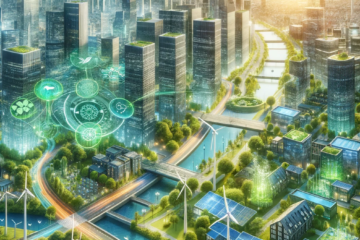The digital age has ushered in an era of unprecedented technological advancements, with data centers at the heart of this revolution. These nerve centers of the internet have traditionally been massive energy consumers, with a significant environmental footprint. However, the tide is turning with the rise of the green data center, a new paradigm that prioritizes energy efficiency in computing. This article delves into the evolution, significance, and future of green data centers within the realms of Green Technology, Sustainability, Data Analytics, and Technological Advancements.
Green Technology: Pioneering Sustainable Computing
The concept of green technology within data centers is a revolutionary step towards sustainable computing. It encompasses the use of energy-efficient designs, renewable energy sources, and advanced cooling mechanisms to minimize energy consumption and reduce carbon emissions. Innovations such as liquid cooling, the use of outside air for cooling, and the implementation of smart energy management systems are at the forefront of transforming data centers from energy guzzlers to models of efficiency.
The Shift to Renewable Energy Sources
Renewable energy sources, including solar, wind, and hydroelectric power, are becoming integral to the energy mix of green data centers. By harnessing the power of nature, these facilities significantly reduce their reliance on fossil fuels, thereby decreasing their carbon footprint. The transition is not just environmentally beneficial; it’s also economically viable, offering long-term savings and energy price stability.
Advanced Cooling Techniques
Cooling systems are among the most energy-intensive components of traditional data centers. Green data centers are pioneering the use of advanced cooling technologies that significantly reduce energy consumption. Techniques such as liquid immersion cooling and the utilization of ambient air eliminate the need for traditional air conditioning units, leading to substantial energy savings.
Energy Efficiency Through Design
The architectural design of a data center plays a crucial role in its energy efficiency. Green data centers adopt innovative design strategies that optimize airflow, reduce electrical losses, and leverage natural environmental conditions. These designs often include features such as green roofs, which provide insulation and reduce cooling needs, and modular construction, which allows for scalable, energy-efficient expansion.
Sustainability: Reducing the Environmental Footprint
Sustainability in data centers goes beyond just energy efficiency; it encompasses a holistic approach to minimize the environmental impact of digital infrastructure. This includes the responsible sourcing of materials, waste reduction, and the recycling of heat waste for community heating projects.
The Circular Economy in Data Centers
Green data centers are pivotal in advancing the circular economy within the tech industry. By prioritizing the refurbishment, reuse, and recycling of hardware, these facilities significantly reduce electronic waste. This approach not only conserves resources but also reduces the environmental impact associated with the production and disposal of electronic components.
Heat Reuse: A Sustainable Solution
One innovative aspect of green data centers is their ability to reuse waste heat. Excess heat generated by servers can be captured and repurposed for district heating systems, providing a sustainable source of energy for local communities. This not only enhances the data center’s energy efficiency but also contributes to a reduction in overall heating costs and carbon emissions in the surrounding area.
Water Conservation Strategies
Water usage is another critical environmental aspect of data centers. Green data centers implement water conservation measures such as using rainwater for cooling and deploying water-efficient cooling technologies. These strategies significantly reduce the water footprint of data centers, contributing to the overall sustainability of the operations.
Data Analytics: Optimizing Energy Use
Data analytics plays a crucial role in enhancing the energy efficiency of green data centers. Through the collection and analysis of vast amounts of data, operators can identify inefficiencies, predict maintenance needs, and optimize energy use in real-time.
Real-time Energy Monitoring
Advanced monitoring systems equipped with IoT sensors provide real-time insights into energy consumption, temperature, and humidity levels within a data center. This enables operators to make immediate adjustments to optimize energy use, prevent overheating, and ensure the smooth operation of all systems.
Predictive Maintenance and Efficiency
Data analytics also facilitates predictive maintenance, allowing data center operators to anticipate and address potential issues before they lead to system failures or inefficiencies. By analyzing patterns and predicting equipment failures, data centers can reduce downtime, extend the lifespan of their hardware, and maintain optimal energy efficiency.
AI-Driven Optimization
Artificial intelligence (AI) and machine learning algorithms are increasingly being employed to automate and optimize energy management in green data centers. These technologies can analyze complex datasets to identify patterns and inefficiencies, automatically adjusting systems for peak performance and energy savings.
Technological Advancements: Shaping the Future of Green Data Centers
The future of green data centers is intrinsically linked to ongoing technological advancements. Innovations in energy storage, AI, and quantum computing are set to further revolutionize the efficiency and sustainability of data center operations.
The Role of Energy Storage
Energy storage technologies, such as batteries and fuel cells, are becoming key components of green data centers. They allow for the storage of renewable energy, providing a reliable power supply during periods of low sunlight or wind. This enhances the energy independence and resilience of data centers, reducing their reliance on the grid.
Quantum Computing and Energy Efficiency
Quantum computing holds the promise of significantly reducing the computational energy requirements of data centers. By performing complex calculations more efficiently than traditional computers, quantum computers could drastically cut the energy consumption of data processing tasks.
The Integration of AI and IoT
The integration of AI and IoT technologies continues to drive the evolution of green data centers. These technologies enable smarter, more autonomous operations, optimizing energy use and reducing the environmental impact of digital infrastructure.
Conclusion
The rise of the green data center represents a pivotal shift towards sustainability and energy efficiency in the realm of computing. By embracing green technology, sustainable practices, data analytics, and technological advancements, these facilities are setting new standards for the digital age. As we continue to rely more heavily on digital services, the importance of green data centers in reducing the environmental impact of our digital footprint cannot be overstated. The journey towards sustainable computing is not without its challenges, but the evolution of green data centers offers a promising path forward, balancing technological progress with environmental stewardship.




